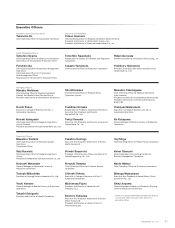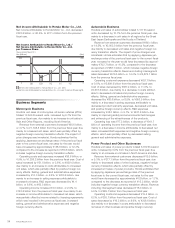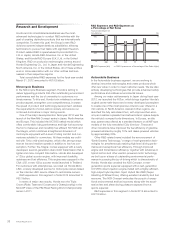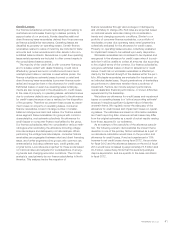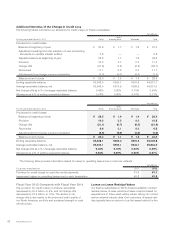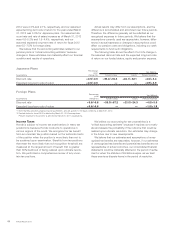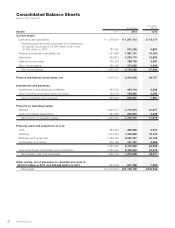Honda 2012 Annual Report Download - page 42
Download and view the complete annual report
Please find page 42 of the 2012 Honda annual report below. You can navigate through the pages in the report by either clicking on the pages listed below, or by using the keyword search tool below to find specific information within the annual report.
If our estimates of unrecognized tax benefits and potential
tax benefits are not representative of actual outcomes, our
consolidated financial statements could be materially affected
in the period of settlement or when the statutes of limitations
expire, as we treat these events as discrete items in the
period of resolution. Since it is difficult to estimate actual
payment in the future related to our uncertain tax positions,
unrecognized tax benefit totaled ¥43,627 million is not repre-
sented in the table above.
At March 31, 2012, we had no material capital lease obliga-
tions or long-term liabilities reflected on our balance sheet
under U.S. GAAP other than those set forth in the table on the
previous page.
Trend Information
Honda uses principally the declining-balance method for calcu-
lating the depreciation of property, plant and equipment, and
plans to change it to the straight-line method from the fiscal
year ending March 31, 2013. We believe that the straight-line
method better reflects the future usage of property plant and
equipment. The effect of the change in depreciation method is
recognized prospectively as a change in accounting estimate.
The change in depreciation method is anticipated to cause a
decrease in depreciation expense by approximately ¥40.0
billion for the fiscal year ending March 31, 2013.
Application of Critical Accounting Policies
Critical accounting policies are those which require us to
apply the most difficult, subjective or complex judgments,
often requiring us to make estimates about the effect of mat-
ters that are inherently uncertain and which may change in
subsequent periods, or for which the use of different esti-
mates that could have reasonably been used in the current
period would have had a material impact on the presentation
of our financial condition and results of operations. Further
changes in the economic environment surrounding us, effects
by market conditions, effects of currency fluctuations or other
factors have combined to increase the uncertainty inherent in
such estimates and assumptions.
The following is not intended to be a comprehensive list of
all our accounting policies.
We have identified the following critical accounting policies
with respect to our financial presentation.
Product Warranty
We warrant our products for specific periods of time.
Product warranties vary depending upon the nature of
the product, the geographic location of their sales and
other factors.
We recognize costs for general warranties on products we
sell and product recalls. We provide for estimated warranty
costs at the time products are sold to customers or the time
new warranty programs are initiated. Estimated warranty
costs are provided based on historical warranty claim experi-
ence with consideration given to the expected level of future
warranty costs, including current sales trends, the expected
number of units to be affected and the estimated average
repair cost per unit for warranty claims. Our products contain
certain parts manufactured by third party suppliers. Since
suppliers typically warrant these parts, the expected receiv-
ables from warranties of these suppliers are deducted from
our estimates of accrued warranty obligations.
We believe our accrued warranty liability is a “critical
accounting estimate” because changes in the calculation can
materially affect net income attributable to Honda Motor Co.,
Ltd., and require us to estimate the frequency and amounts
of future claims, which are inherently uncertain.
Our policy is to continuously monitor warranty cost accru-
als to determine the adequacy of the accrual. Therefore,
warranty expense accruals are maintained at an amount we
deem adequate to cover estimated warranty expenses.
Actual claims incurred in the future may differ from the
original estimates, which may result in material revisions to
the warranty expense accruals.
The changes in provisions for those product warranties
and net sales and other operating revenue for each of the
years in the three-year period ended March 31, 2012 are
as follows:
Yen (millions)
Fiscal years ended March 31 2011 2012
Provisions for product
warranties
Balance at beginning of year ¥ 226,038 ¥ 213,943
Warranty claims paid during
the period (82,080) (82,547)
Liabilities accrued for
warranties issued during
the period 84,920 60,004
Changes in liabilities for
pre-existing warranties
during the period* (3,550) (17,697)
Foreign currency translation (11,385) (3,141)
Balance at end of year 213,943 170,562
Net sales and other operating
revenue ¥8,936,867 ¥7,948,095
Note: Changes in liabilities for pre-existing warranties during the period for the
fiscal year ended March 31, 2012, was ¥17.6 billion, due mainly to the
change of the expected level of future warranty costs, including the
expected number of units to be affected and estimated average repair
cost per unit for product recalls.
Annual Report 201240



